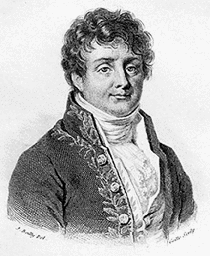A Short Account of the History of Mathematics
by W.W. Rouse Ball
John Baptiste Joseph Fourier
Additional Information
- Year Published: 1908
- Language: English
- Country of Origin: England
- Source: Ball, W.W.R. (1908). A Short Account of the History of Mathematics. London, New York: Macmillan.
-
Readability:
- Flesch–Kincaid Level: 12.0
- Word Count: 450
- Genre: History
- Keywords: biography
- ✎ Cite This
Downloads

Jean Baptiste Joseph Fourier was born at Auxerre on March 21, 1768, and died at Paris on May 16, 1830. He was the son of a tailor, and was educated by the Benedictines. The commissions in the scientific corps of the army were, as is still the case in Russia, reserved for those of good birth, and being thus ineligible he accepted a military lectureship on mathematics. He took a prominent part in his own district in promoting the revolution, and was rewarded by an appointment in 1795 in the Normal school, and subsequently by a chair in the Polytechnic school.
Fourier went with Napoleon on his Eastern expedition in 1798, and was made governor of Lower Egypt. Cut off from France by the English fleet, he organized the workshops on which the French army had to rely for their munitions of war. He also contributed several mathematical papers to the Egyptian Institute which Napoleon founded at Cairo, with a view of weakening English influence in the East. After the British victories and the capitulation of the French under General Menou in 1801, Fourier returned to France, and was made prefect of Grenoble, and it was while there that he made his experiments on the propagation of heat. He moved to Paris in 1816. In 1822 he published his Théorie analytique de la chaleur, in which he bases his reasoning on Newton's law of cooling, namely, that the flow of heat between two adjacent molecules is proportional to the infinitely small difference of their temperatures. In this work he shows that any functions of a variable, whether continuous or discontinuous, can be expanded in a series of sines of multiples of the variable - a result which is constantly used in modern analysis. Lagrange had given particular cases of the theorem, and had implied that the method was general, but he had not pursued the subject. Dirichlet was the first to give a satisfactory demonstration of it.
Fourier left and unfinished work on determinate equations which was edited by Navier, and published in 1831; this contains much original matter, in particular there is a demonstration of Fourier's theorem on the position of the roots of an algebraical equation. Lagrange had shewn how the roots of an algebraical equation might be separated by means of another equation whose roots were the squares of the differences of the roots of the original equation. Budan, in 1807 and 1811, had enunciated the theorem generally known by the name of Fourier, but the demonstration was not altogether satisfactory. Fourier's proof is the same as that usually given in textbooks on the theory of equations. The final solution of the problem was given in 1829 by Jacques Charles François Sturm (1803—1855).